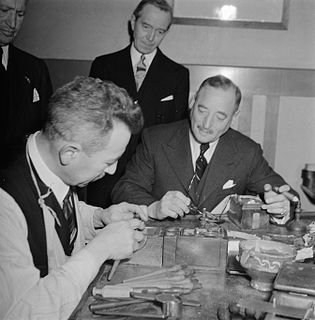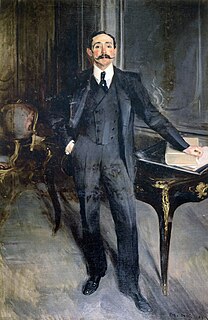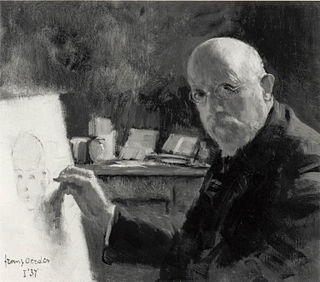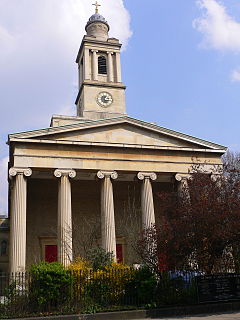
Harry Frederick Oppenheimer was a prominent South African businessman, industrialist and philanthropist. Oppenheimer was often ranked as one of the wealthiest people in the world. In 2004 he was voted 60th in the SABC3's Great South Africans.

Kimberley is the capital and largest city of the Northern Cape Province of South Africa. It is located approximately 110 km east of the confluence of the Vaal and Orange Rivers. The city has considerable historical significance due to its diamond mining past and the siege during the Second Boer War. British businessmen Cecil Rhodes and Barney Barnato made their fortunes in Kimberley, and Rhodes established the De Beers diamond company in the early days of the mining town.

Sir Ernest Oppenheimer was a diamond and gold mining entrepreneur, financier and philanthropist, who controlled De Beers and founded the Anglo American Corporation of South Africa.

Sir Julius Charles Wernher, 1st Baronet was a German-born Randlord and art collector who became part of the English establishment.
Asher Bilu is an Australian artist who creates paintings, sculptures and installations. He has also contributed to several films by Director Paul Cox as production designer. He was born in Israel, and began his career as an artist soon after arriving in Australia in 1956. From the start, his art has been abstract, with particular emphasis on technological experimentation. His technique changes as he investigates the use of new media, but his work always reflects his fascination with light, and his love of music and science, especially cosmology.
Randlords were the entrepreneurs who controlled the diamond and gold mining industries in South Africa in it's pioneer phase from the 1870s up to World War I.

Marshall Philip Baron (1934–1977) was a Rhodesian painter. He exhibited in the United States and South Africa, as well as in Rhodesia. Some of his paintings are today in the National Gallery of Zimbabwe.
Buysile "Billy" Mandindi (1967–2005) was a black South African activist-artist who participated in a landmark protest in Cape Town in 1989, the so-called Purple Rain Protest. Later, still covered with the purple dye that riot police sprayed on protesters, Mandindi created a lino cut celebrating the spirit of freedom.

Sir Maximillian Michaelis, was a South African financier, mining magnate, benefactor and patron of the arts.

Sir Lionel Phillips, 1st Baronet was a British-born South African financier, mining magnate and politician.
William Miller Macmillan, England is regarded as a founder of the liberal school of South African historiography and as a forerunner of the radical school of historiography that emerged in the 1970s. He was also a critic of colonial rule and an early advocate of self-government for colonial territories in Africa and of what became known as development aid.
Robert Hodgins was an English painter and printmaker.
Cyril Fradan (1928–1997) was a South African artist and designer who worked almost exclusively in acrylic paints incorporating various glazing techniques.
Jack Penn, M.B., Ch.B., F.R.C.S.(E.)., Mil. Dec. M.B.E., S.M., was a plastic and reconstructive surgeon, sculptor and author, who was also for a time a member of the President's Council in South Africa.

Frans David Oerder was a Dutch-born South African landscape, still-life and portrait painter, etcher and lithographer.
Moses Kottler (1896–1977) was a South African painter and sculptor. He is widely regarded, along with Anton van Wouw and Lippy Lipshitz, as one of the most important South African sculptors. This triumvirate had the distinction of also having excelled at using pictorial media; Lipshitz with monotypes and Van Wouw in painting and drawing. Kottler's work in oils earned him additional consideration as a painter.
The traditional religion and mythology of the San people is poorly attested due to their interactions with Christianity.
Walter Edward Westbrook was a South African artist who lived latterly in Kent, England. He was well known particularly for his watercolour landscapes inspired by the arid plains of the Northern Cape and Namibia, and later by the countryside of Kent and the English Channel. Westbrook was born in Pretoria in 1921 and lived in Kimberley for several decades before emigrating to England in the late 1990s. He died in Kent in 2015, aged 93.
Allerley Glossop (1870–1955) was a South African artist known particularly for her landscape and pastoral scenes.
Kagiso Patrick "Pat" Mautloa is an multi-media visual artist based in Johannesburg, South Africa.





















